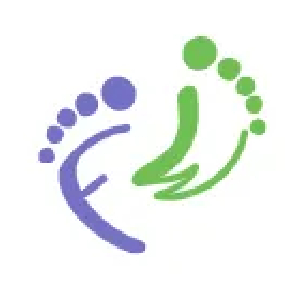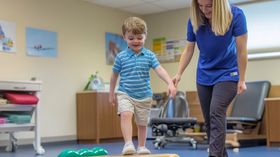How to Fix Flat Feet in Toddlers: Exploring Potential Solutions
Wondering if your toddler's flat feet need treatment? Most children develop arches naturally, but some may need extra support. Find out when to watch and wait versus when to take action with our complete guide to toddler foot health.
Published May 18, 2025

Are you concerned about your little one's flat feet? This is a common worry among parents, but the good news is that in most cases, it's completely normal.
Let's explore what flat feet in toddlers really mean, when you should be concerned, and what solutions are available if treatment is needed.
» Find supportive shoes for your tot in our Orthopaedic Collection
Understanding Flat Feet in Toddlers
What Are Flat Feet?
When we talk about flat feet in toddlers, we're referring to a condition where the arch of the foot is completely absent when your child is standing or bearing weight. You might notice that their entire foot touches the ground, and their heel may roll inward (pronate) more than usual.
Interestingly, many toddlers with flat feet will show a visible arch when sitting or standing on tiptoes, which is an important distinction we'll discuss later.
Is It Normal for My Baby to Have Flat Feet?
Yes, almost all babies and young toddlers have flat-looking feet! This is completely normal and part of their development.
The arch of a child's foot can take up to 6 years to develop fully[1], and nearly all children under 18 months of age appear to have flat feet. This doesn't mean there's anything wrong—their feet are simply still developing.
» Parents also asked: Do all babies have flat feet?
Normal Development vs. True Flat Feet
It's important to understand the difference between a normally developing baby's foot and true flat feet. In normal development, while the arch may not be visible when standing, the heel alignment will be neutral rather than rolled inward.
True flat feet involve both the absence of an arch and excessive inward rolling of the heel when bearing weight.
Should You Be Concerned?
The good news is that most children will naturally outgrow flat feet by age 3-6 years without requiring any treatment at all. Another 5-10% may not develop arches until they're about 10 years old but still remain asymptomatic (without symptoms).
Only a very small percentage of children (about 1-2%) will experience issues associated with their flat feet, such as:
- Pain or discomfort
- Difficulty walking, running, or balancing
- Unusual fatigue during physical activities
- Abnormal wear patterns on shoes
If your child is experiencing any of these symptoms, it might be time to consult with a healthcare professional.
» Find out if it's time to see a professional for flat feet
Types of Flat Feet in Toddlers
Flexible Flat Feet
Most toddlers with flat feet have what's called "flexible" flat feet[2]. This means:
- An arch appears when they sit or stand on tiptoes
- The arch disappears when they stand normally
- The foot is relatively pain-free
- It's typically a natural part of development
Flexible flat feet can be hereditary—if you or your partner have flat feet, your child may be more likely to have them too. Children with hypermobility (unusually flexible joints) may also be more prone to developing flat feet.
Rigid Flat Feet
Less common but more concerning are "rigid" flat feet, where:
- The arch doesn't appear even when your child sits or stands on tiptoes
- The foot may be stiff and inflexible
- There may be associated pain or discomfort
- It's often linked to underlying conditions
Rigid flat feet may be associated with neurological disorders (like cerebral palsy), genetic conditions, or congenital foot defects. These cases typically require medical attention.
Solutions for Flat Feet in Toddlers
If your child has symptomatic flat feet (causing pain or affecting movement), there are several treatment options available. Let's explore these from least to most invasive.
Simple Monitoring
For most toddlers with flat feet who aren't experiencing any symptoms, the best approach is simply to monitor their development. Regular check-ups with your GP or paediatrician should be sufficient to track their progress. Remember, patience is key—development of the arch can take several years.
Supportive Footwear
If your child has mild symptoms with their flat feet, supportive footwear might be the first treatment option to consider. These orthopedic shoes provide:
- Arch support through specially designed insoles
- Heel support (sometimes called a "Thomas heel")
- Proper cushioning to reduce strain on the feet
Good supportive shoes help align your child's feet properly, preventing discomfort and aiding normal development. When shopping for shoes, look for:
- Firm heel counters that cup the heel
- Flexible soles in the forefoot area
- Adequate width in the toe box
- Good arch support
» Discover more about the role of arch support in children's shoes
Custom Orthotics
For children with more pronounced symptoms, custom orthotics might be recommended. These specially designed inserts fit inside normal shoes and provide targeted support to correct alignment issues. They're particularly useful for:
- Children with significant pain or discomfort
- Toddlers who have difficulty walking or running
- Cases where flat feet are affecting overall posture
- Children with associated issues like knock knees
Orthotics come in different forms[3]:
- In-shoe inserts made from compressible materials
- UCBL orthoses (rigid arch supports with heel cups)
- Supramalleolar orthoses (extending above the ankle for severe cases)
These should always be prescribed by a qualified professional such as a podiatrist or orthopaedic specialist.
» Find the best orthotics-friendly shoes for your stylish toddler
Physiotherapy
Physiotherapy can be incredibly beneficial for toddlers with symptomatic flat feet. A well-designed physiotherapy programme works by:
- Improving flexibility in tight calf muscles and foot tissues
- Strengthening the intrinsic foot muscles that support the arch
- Training proper posture and movement patterns
- Enhancing balance and coordination
- Building muscle endurance for sustained activity
Simple exercises your physiotherapist might recommend include:
- Walking on tiptoes or heels
- Picking up marbles or small toys with toes
- Scrunching towels with feet
- Balance exercises on different surfaces
- Gentle stretching of the calf muscles
These exercises should be fun and integrated into playtime rather than feeling like a chore.
» Discover more exercises to help with flat feet
Surgical Options (Rarely Needed)
It's important to note that surgery is rarely needed for flat feet in toddlers. Surgical intervention is typically only considered when conservative treatments have failed or the child experiences severe pain or disability.
Doctors may also recommend surgery if there's an underlying structural issue that won't resolve on its own, or when the flat feet are rigid rather than flexible. These situations are uncommon, and most children respond well to non-invasive approaches.
If surgery is deemed necessary, options might include:
- Subtalar arthroereisis[4] (insertion of a small implant to support the foot)
- Tendon transfers or lengthening procedures
- Bone procedures (osteotomies) to realign the foot
These decisions should only be made after thorough consultation with paediatric orthopaedic specialists.
Special Considerations
One-Sided Flat Feet
If your child has flat feet on only one side, or shows asymmetry in their stance or gait, it's particularly important to seek professional advice. One-sided flat feet may indicate:
- Structural abnormalities like tarsal coalition
- Neuromuscular disorders
- Leg length differences
- Other orthopaedic conditions like hip dysplasia
These situations require specialised assessment to rule out underlying issues.
Compensatory Movement Patterns
Children with persistent flat feet may develop compensatory movement patterns such as toe walking or inward knee collapse (knock knees). These adaptations occur as the body attempts to maintain balance and function despite foot misalignment.
If you notice your toddler consistently walking on their toes or their knees turning inward when they walk, mention this to your healthcare provider. These patterns can affect the entire body's alignment and may need addressing through physiotherapy or orthotics.
» Let's find out if your child is walking correctly
At-Home Care Tips
While working with healthcare professionals, there's plenty you can do at home to support your child's foot development:
- Encourage barefoot play on different surfaces when safe
- Limit time in restrictive footwear when possible
- Engage in fun activities that strengthen feet (beach walks, balance games)
- Follow through with any prescribed exercises or stretches
- Ensure shoes fit properly and provide good support
- Schedule regular follow-up appointments to monitor progress
» Learn more about what makes a shoe orthotics-friendly
When to Seek Professional Help
While flat feet in toddlers are usually nothing to worry about, you should consult a healthcare professional if you notice:
- Pain or discomfort when walking
- Unusual walking patterns that persist
- Significant asymmetry between feet
- Stiffness or inflexibility in the feet
- Your child is avoiding physical activities
- Excessive wear on certain parts of the shoes
Early intervention, when needed, can prevent more significant issues later on.
» Learn more about treating flat feet in children
The Path to Happy, Healthy Feet
Remember that flat feet are a normal part of development for most toddlers, and the vast majority will develop arches naturally without any intervention. For the small percentage who need support, there are plenty of effective, non-invasive options available.
By understanding what's normal, monitoring your child's development, and seeking professional advice when needed, you can ensure your little one develops healthy feet for a lifetime of activity and movement.
Trust your parental instincts, stay informed, and remember that each child develops at their own pace.
» Shop our Orthopaedic Collection for happy, healthy little feet
Disclaimer: First Walkers' information is intended for educational and informational purposes related to toddler footwear and feet. We encourage you to consider individual circumstances and consult qualified orthopedists about specific conditions.
References
B. Grueger, S. C. De Pédiatrie, and C. De La Pédiatrie Communautaire, “Footwear in children,” Paediatrics & Child Health, vol. 14, no. 2, p. 121, Feb. 2009, doi: 10.1093/pch/14.2.121. Available: https://pmc.ncbi.nlm.nih.gov/articles/PMC2661351/?
A. Atik, “Flexible flatfootness,” Northern Clinics of Istanbul, vol. 1, no. 1, pp. 57–63, Jan. 2014, doi: 10.14744/nci.2014.29292. Available: https://doi.org/10.14744/nci.2014.29292
“Paediatric pes planus,” Australian Journal of General Practice. Available: https://www1.racgp.org.au/ajgp/2020/may/paediatric-pes-planus?
Europe PMC, “Europe PMC.” Available: https://europepmc.org/article/med/35154977






